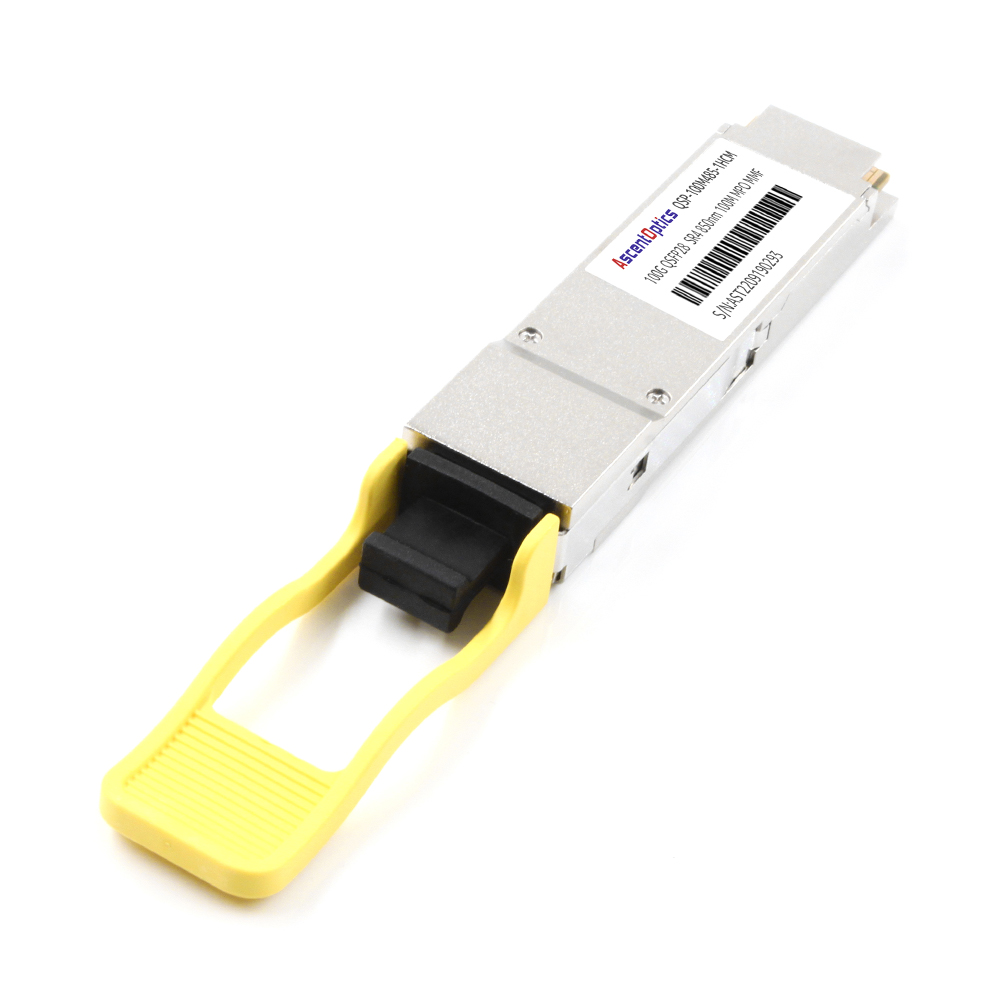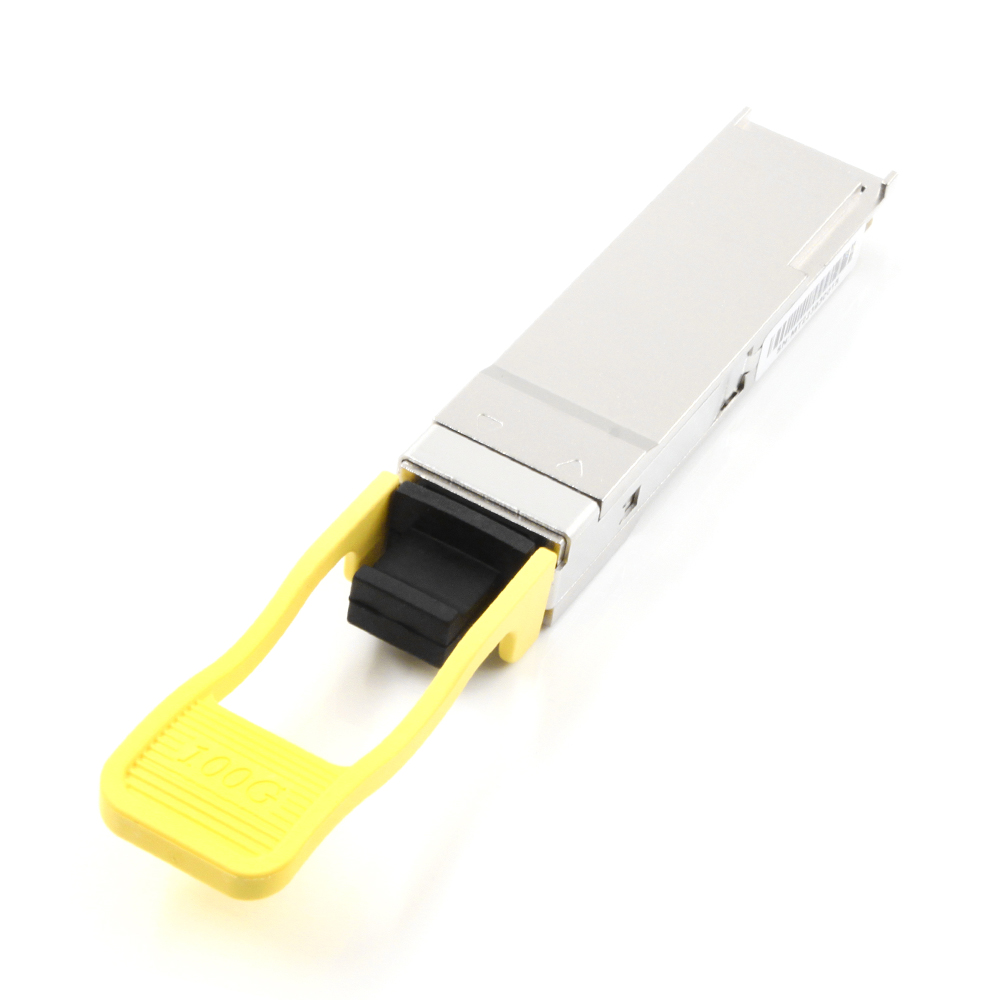
The 100g SR4 Optical Transceiver Module is a high-speed, short-reach optical module that operates on a wavelength of 850nm. It is designed to transmit data at 100 Gbps over four parallel multimode fibers and has a form factor of QSFP28.
The primary purpose of the 100g SR4 Optical Transceiver Module is to enable energy-efficient data transmission over short distances. It uses four parallel fibers to support data transfer at a rate of 100 Gbps, making it suitable for high-speed data centers where quick data transfer is essential. The module uses 850nm VCSEL technology for better signal integrity and high performance.
The 100g SR4 Optical Transceiver Module offers several benefits over other data transmission solutions. It uses less power and produces less heat, reducing operating costs and increasing energy efficiency. This module also supports multimode fiber, which enables transmission over longer distances and allows connectivity between devices with different types of connectors.
The 100g SR4 Optical Transceiver Module is compatible with various connector types, including MTP/MPO and LC. It supports connectivity between devices, such as routers and switches, and can connect servers, buttons, and storage devices in data centers. The module can also be used in high-performance and cloud computing applications, where high-speed data transfer is essential.
The 100g SR4 Optical Transceiver Module operates on a wavelength of 850nm, within the visible light range. This wavelength enables high-speed data transmission over OM3 and OM4 multimode fiber cables, commonly used in data centers. The use of multimode fiber cables enables reduced installation costs, as well as higher data transfer speeds over longer distances.
The 100g SR4 Optical Transceiver Module has a low power consumption of less than 3.5 watts, making it an energy-efficient solution for data centers. It also has a wide operating temperature range of 0°C to 70°C, allowing it to function even in challenging environments. These factors contribute to reduced operational costs and increased reliability in data center environments.
In conclusion, the 100g SR4 Optical Transceiver Module is a high-speed, energy-efficient solution that supports data transmission over short distances in data center environments. Its compatibility with a wide range of connectors and multimode fiber cables makes it a versatile solution that supports high-speed data transfer and connectivity between different devices. Low power consumption and a wide operating temperature range make it an efficient and reliable solution for modern data centers.

100g SR4 is a transceiver module that operates on the QSFP28 interface. It supports data rates of up to 100Gbps, making it ideal for high-density applications such as data centers.
Modern data centers have numerous components, such as servers, storage systems, switches, and routers. The connectivity between these components requires high-speed and reliable connections. 100g SR4 is crucial in maintaining network efficiency in these data centers. It’s compatible with multimode and single-mode fiber, providing users with more flexibility in their network design. Its small form factor and low power consumption make it an ideal solution for high-density applications.
100g SR4 is just one of the many transceiver modules that support data rates of up to 100Gbps. Other modules include 100g PSM4, 100g CWDM4, and 100g LR4. Each of these modules has its specific functionalities and applications. 100g SR4 is the most cost-effective and compatible with most data center designs compared to the other modules. It’s flexibility and small form factor make it an ideal solution for high-density applications.
Real-world testing and results are essential aspects of any technical product review. Several customers have tested and provided feedback on the performance of 100g SR4. Their thoughts are generally positive, highlighting its compatibility with most data center designs and high-speed connectivity solutions. Additionally, users have praised the low power consumption and small form factor of 100g SR4.
As with any other product, cost is a crucial factor to consider when selecting a transceiver module. As stated earlier, 100g SR4 is the most cost-effective solution compared to other 100g transceiver modules. However, other compatible QSFP28 options, such as 100g LR4 and 100g PSM4, also offer similar functionalities. It’s essential to explore all the compatible QSFP28 options and their costs to make an informed decision.
Lastly, it’s crucial to highlight the benefits of 100g SR4. Its high data rate of up to 100Gbps makes it an excellent solution for high-density applications like data centers. Additionally, it’s compatible with the Multi-Source Agreement (MSA) standards, ensuring interoperability with other networking equipment. These benefits make 100g SR4 an ideal choice for modern data centers.

As one of the latest advancements in fiber optic technology, it’s no wonder why people still have plenty of questions and concerns about 100g SR4 technology. This article will address some of the most frequently asked questions about 100g SR4 and provide readers with a comprehensive understanding of the technology.
The answer is yes. 100g SR4 QSFP28 technology can support 100 meters of OM4, the most commonly used multimode fiber optic cable. This distance is possible because of the advanced electronic equalization technology in 100g SR4.
The optimal temperature range for 100g SR4 is from 0°C to 70°C. This temperature range ensures that the technology operates smoothly and efficiently. Excessively high or low temperatures can cause signal loss, affecting the system’s performance.
100g SR4 technology comes with digital optical monitoring (DOM) features that allow users to monitor the overall visual performance of the system. DOM sensors can detect the presence of ambient light, temperature, and voltage. Additionally, the technology uses MPO connectors, which are designed to accommodate four 25G channels in a single interface, increasing the system’s overall efficiency.
Recommended Products:100G QSFP28 SR4 850nm 100m Transceivers
One of the advantages of 100g SR4 technology is its compact form factor. The technology is designed to support an increased port density, meaning that users can install more transceivers in a single chassis, improving overall performance and reducing operational costs.
100g SR4 technology requires a rigorous testing process to ensure that the technology functions optimally. During quality testing, it is essential to verify the compatibility of the technology with other components in the system, including cabling and other hardware. Additionally, it is necessary to implement best practices, such as handling the technology with care and ensuring that proper cleaning procedures are followed to reduce contamination and signal loss.
In summary, 100g SR4 technology is a robust advancement in fiber optic technology that presents a range of user benefits. Understanding the technology’s optimal temperature range, form factor advantages, quality testing considerations, and other features can help ensure that users get the most out of 100g SR4 technology.

A: 100g SR4 refers to the 100Gbps Ethernet standard that uses a multimode fiber (MMF) and is transmitted through four parallel fibers at 850nm wavelength. The 100g SR4 QSFP28 optical transceiver module supports this standard and is compatible with various devices.
A: The key features of 100g SR4 include: 100Gbps data rate, 850nm wavelength, support for up to 100 meters on OM3 MMF or 70m on OM4 MMF, QSFP28 form factor, and compatibility with 100GBase-SR4 QSFP28.
A: 100g SR4 is compatible with OM3 and OM4 MMF optical cables with LC connectors. The wires should be compliant with IEEE 802.3ba standards.
A: 100g SR4 can support up to 100 meters on OM3 MMF or 70 meters on OM4 MMF optical cables.
A: The transceiver is essential in 100g SR4 as it converts electrical signals into optical signals and vice versa. It plays a crucial role in enabling high-speed data transfer over an optical cable.
A: QSFP and QSFP28 are both form factors for optical transceivers, but QSFP28 is a newer and smaller form factor that supports higher bandwidth and data rates.
A: Single-mode fiber uses a smaller core that allows for higher data transmission over longer distances, while multimode fiber uses a larger body and can support shorter distances at a lower cost.
A: Quality testing for 100g SR4 involves rigorous testing of transceiver modules to ensure they meet industry standards for reliability, performance, and compatibility. This includes testing for temperature range, signal strength, and interconnectivity with other devices.
A: Yes, the 100gbase-sr4 qsfp28 optical transceiver module is compatible with Cisco devices, including the Cisco QSFP-100G-SR4-S consistent 100Gbase-SR4 QSFP28.
A: The optical transceiver module converts electrical signals into optical signals and vice versa. It bridges the electrical network interface and the visual network interface in 100g SR4.